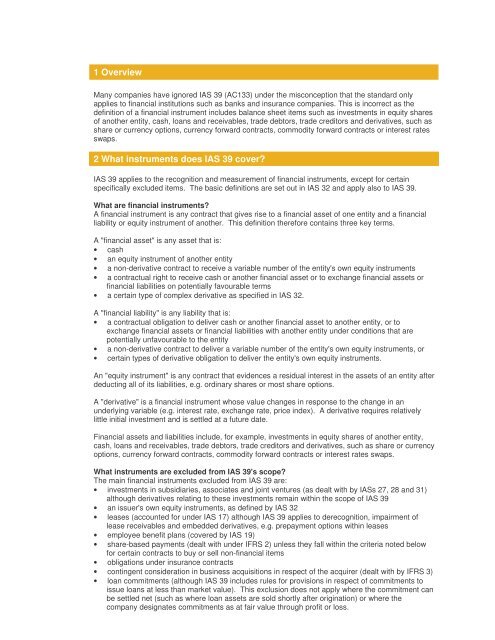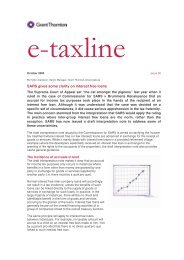e-IFRSline May 06 - IAS 39: Financial Instruments - Grant Thornton
e-IFRSline May 06 - IAS 39: Financial Instruments - Grant Thornton
e-IFRSline May 06 - IAS 39: Financial Instruments - Grant Thornton
- No tags were found...
Create successful ePaper yourself
Turn your PDF publications into a flip-book with our unique Google optimized e-Paper software.
1 OverviewMany companies have ignored <strong>IAS</strong> <strong>39</strong> (AC133) under the misconception that the standard onlyapplies to financial institutions such as banks and insurance companies. This is incorrect as thedefinition of a financial instrument includes balance sheet items such as investments in equity sharesof another entity, cash, loans and receivables, trade debtors, trade creditors and derivatives, such asshare or currency options, currency forward contracts, commodity forward contracts or interest ratesswaps.2 What instruments does <strong>IAS</strong> <strong>39</strong> cover?<strong>IAS</strong> <strong>39</strong> applies to the recognition and measurement of financial instruments, except for certainspecifically excluded items. The basic definitions are set out in <strong>IAS</strong> 32 and apply also to <strong>IAS</strong> <strong>39</strong>.What are financial instruments?A financial instrument is any contract that gives rise to a financial asset of one entity and a financialliability or equity instrument of another. This definition therefore contains three key terms.A "financial asset" is any asset that is:• cash• an equity instrument of another entity• a non-derivative contract to receive a variable number of the entity's own equity instruments• a contractual right to receive cash or another financial asset or to exchange financial assets orfinancial liabilities on potentially favourable terms• a certain type of complex derivative as specified in <strong>IAS</strong> 32.A "financial liability" is any liability that is:• a contractual obligation to deliver cash or another financial asset to another entity, or toexchange financial assets or financial liabilities with another entity under conditions that arepotentially unfavourable to the entity• a non-derivative contract to deliver a variable number of the entity's own equity instruments, or• certain types of derivative obligation to deliver the entity's own equity instruments.An "equity instrument" is any contract that evidences a residual interest in the assets of an entity afterdeducting all of its liabilities, e.g. ordinary shares or most share options.A "derivative" is a financial instrument whose value changes in response to the change in anunderlying variable (e.g. interest rate, exchange rate, price index). A derivative requires relativelylittle initial investment and is settled at a future date.<strong>Financial</strong> assets and liabilities include, for example, investments in equity shares of another entity,cash, loans and receivables, trade debtors, trade creditors and derivatives, such as share or currencyoptions, currency forward contracts, commodity forward contracts or interest rates swaps.What instruments are excluded from <strong>IAS</strong> <strong>39</strong>'s scope?The main financial instruments excluded from <strong>IAS</strong> <strong>39</strong> are:• investments in subsidiaries, associates and joint ventures (as dealt with by <strong>IAS</strong>s 27, 28 and 31)although derivatives relating to these investments remain within the scope of <strong>IAS</strong> <strong>39</strong>• an issuer's own equity instruments, as defined by <strong>IAS</strong> 32• leases (accounted for under <strong>IAS</strong> 17) although <strong>IAS</strong> <strong>39</strong> applies to derecognition, impairment oflease receivables and embedded derivatives, e.g. prepayment options within leases• employee benefit plans (covered by <strong>IAS</strong> 19)• share-based payments (dealt with under IFRS 2) unless they fall within the criteria noted belowfor certain contracts to buy or sell non-financial items• obligations under insurance contracts• contingent consideration in business acquisitions in respect of the acquirer (dealt with by IFRS 3)• loan commitments (although <strong>IAS</strong> <strong>39</strong> includes rules for provisions in respect of commitments toissue loans at less than market value). This exclusion does not apply where the commitment canbe settled net (such as where loan assets are sold shortly after origination) or where thecompany designates commitments as at fair value through profit or loss.










